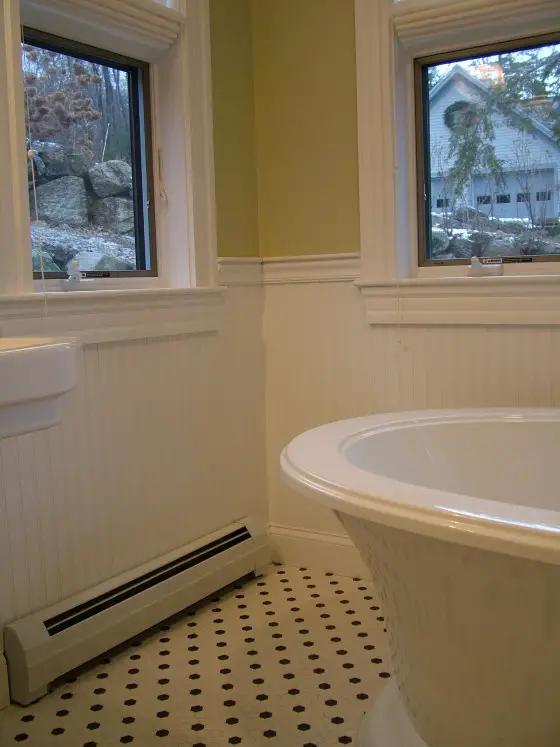Wainscoting

The wainscoting in this bathroom was fairly easy to install, and it really adds character. PHOTO CREDIT: Tim Carter
DEAR TIM: I attended a Christmas party at a home that had wainscoting. It was gorgeous. The beadboard wainscoting was painted a different color that the wall above to accent it. What can you tell me about installing wainscoting? I like raised-panel wainscoting, but would settle for the beadboard wainscoting if I had to. Can you tell me the important things to know about how to install wainscoting? Stephanie D., Minneapolis, MN
DEAR STEPHANIE: You're not the first to be smitten with wainscoting, and you'll surely not be the last. My wife and I have raised-panel wainscoting in our existing home, and it will be installed in the new home we're planning. This traditional wall finish can add character to just about any architectural style. The beadboard wainscoting you saw can produce both a country look as well as a clean, modern look with its vertical lines.
I remember years ago when my sister had her home built. She wanted beadboard wainscoting. I was just getting into construction at the time, and she wanted the real beadboard, not the imposter material that comes in large sheets. I remember installing the horizontal blocking in the walls so there was solid wood to secure the thin vertical strips of tongue and groove beadboard. It wasn't hard to install the blocking, but it's a good idea to do if you want real beadboard.
If you want to install beadboard wainscoting in an existing house where it's too late to install blocking, you can easily get the wood to stick to the walls by adding a dab of construction adhesive to a couple of spots on each board before its nailed at an angle through the tongue
Over the years, I've discovered all sorts of tips about installing wainscoting. Perhaps the biggest time saver is pre-finishing the material before it's installed. This, in my opinion, should be done whether you decide to paint or stain the wood. It's of the utmost importance to make sure you completely coat the entire tongue portion of the wood. The wood can shrink after it's installed. If this happens, it will reveal a vertical thin strip of wood that's unfinished. This can be really problematic if it happens at each joint where the grooved edge of a board overlaps the tongue of the adjacent piece.
It's also easier to paint or stain the wainscoting while it's flat on a workbench or on top of a piece of plywood suspended between two saw horses. You just need to set the finished material inside a covered area away from dirt and dust as it dries.
There are challenges when installing wainscoting in existing homes with respect to electrical outlet boxes. You need to make sure you're code compliant with respect to the distance between the edge of the electrical box and the finished surface of the wainscoting. You may have to install approved extensions to comply with the code. This is not a problem in new construction, as the electrician can mount the boxes so they match up with the surface of the wainscoting.
As you discover how to install wainscoting, one thing you'll quickly see is that you need to be aware of the thickness of the wainscoting and how it plays with the trim around doors and windows that may sit close enough to the floor such that the wainscoting rises up above the window sill. These places where the wainscoting collides with other trim must be dealt with using great skills and often some master-carpentry magic.
You'll sometimes discover that it's best to install the wainscoting before any baseboard trim. To get a really great look at windows and doors in the room, you may have to install extension-jamb filler strips to bring the window and door trim so it sits on top of the wainscoting. I didn't have to do this at my home as my door-casing trim is a full 3/4-inch thick. My wainscoting was only 3/8-inch thick so the door trim still was proud above the surface of the raised-panel wainscoting.
If you decide to install raised-panel wainscoting, it pays to pre-finish the raised panels and all other parts before you assemble them. Some movement may occur with the raised panels that can reveal the unfinished wood.
Raised-panel wainscoting is also harder to work with respect to electrical outlets on the wall. You need to be sure the electrical boxes fall within the flat area of a raised panel. You can't have the outlet boxes where there is a vertical stile or the beveled edge of a raised panel. As you might imagine, this requires lots of planning ahead of time to determine the center of each raised panel.
Some raised-panel wainscoting comes with its own baseboard as part of the system. I used this at my own home with great results. I also used this same wainscoting to provide the facing for my basement wet bar. The bar is done in cherry veneer, while the wainscoting in my dining room is painted a rich gold color.
Column 757
One Response to Wainscoting